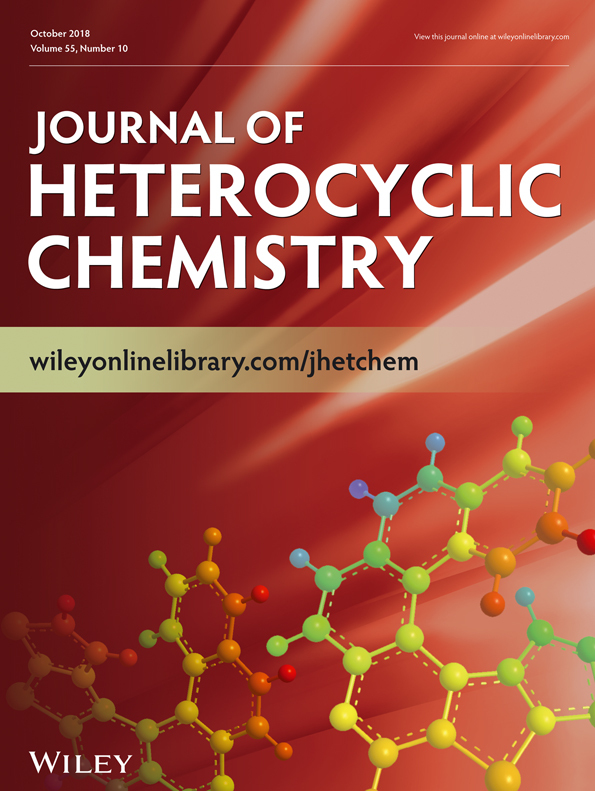Intramolecular Ring Transformation of Bis-oxadiazoles to Bis-thiadiazoles and Investigation of Their Anticancer Activities
Corresponding Author
Sobhi M. Gomha
Department of Chemistry, Faculty of Science, Cairo University, Giza, 12613 Egypt
E-mail: [email protected]Search for more papers by this authorZeinab A. Muhammad
Department of Organic Chemistry, National Organization for Drug Control and Research (NODCAR), Giza, 12311 Egypt
Search for more papers by this authorAhmed A. M. El-Reedy
Department of Basic and Applied Science, Faculty of Oral and Dental Medicine, Nahda University, Beni-Suef, Egypt
Search for more papers by this authorCorresponding Author
Sobhi M. Gomha
Department of Chemistry, Faculty of Science, Cairo University, Giza, 12613 Egypt
E-mail: [email protected]Search for more papers by this authorZeinab A. Muhammad
Department of Organic Chemistry, National Organization for Drug Control and Research (NODCAR), Giza, 12311 Egypt
Search for more papers by this authorAhmed A. M. El-Reedy
Department of Basic and Applied Science, Faculty of Oral and Dental Medicine, Nahda University, Beni-Suef, Egypt
Search for more papers by this authorAbstract
A new series of 2,6-dimethyl-4-phenyl-N′3,N′5-bis(3-phenyl-1,3,4-thiadiazol-2(3H)-ylidene)-1,4-dihydropyridine-3,5-dicarbohydrazides were synthesized from reaction of 5,5′-(2,6-dimethyl-4-phenyl-1,4-dihydropyridine-3,5-diyl)bis(1,3,4-oxadiazole-2-thiol) or diethyl 2,2′-(2,6-dimethyl-4-phenyl-1,4-dihydropyridine-3,5-dicarbonyl)bis(hydrazine-1-carbodithioate) with various hydrazonoyl chlorides. The structures of new compounds were established on the basis of their elemental analysis and IR, 1H NMR, and mass spectral data. The anticancer activities of the synthesized compounds were screened for their activity against human hepatocellular carcinoma (HepG2) cell lines, and the results showed that compounds 6l, 6k, and 6e were the most active (IC50 = 7.68 ± 9.8, 8.72 ± 9.7, and 9.78 ± 9.1 μM, respectively), compared with Cisplatin reference drug (IC50 value of 1.40 ± 1.1 μM).
References and Notes
- 1Radadiya, A.; Khedkar, V.; Bavishi, A.; Vala, H.; Thakrar, S.; Bhavsar, D.; Shah, A.; Coutinho, E. Eur J Med Chem 2014, 74, 375.
- 2Hunter, A.; LaCasse, E.; Korneluk, R. Apoptosis 2007, 12, 1543.
- 3Shekari, F.; Sadeghpour, H.; Javidnia, K.; Saso, L.; Nazari, F.; Firuzi, O.; Miri, R. Eur J Pharmacol 2015, 746, 233.
- 4Hadizadeh, F.; Hassanabad, Z. F.; Bamshad, M.; Poorsoghat, H.; Hassanabad, M. F. Indian J Chem 2005, 44B, 2343.
- 5Jorjani, M.; Rastegar, H.; Roshanzamir, F.; Varmazyari, M.; Abdollahi, M.; Zarghi, A.; Iranian, J. Pharm Res 2003, 2, 43.
- 6Vijesh, A.; Isloor, A.; Peethambar, S.; Shivananda, K.; Arulmoli, T.; Isloor, N. Eur J Med Chem 2011, 46, 5591.
- 7Abu-Melha, H. Spectrochim Acta A Mol Biomol Spectrosc 2013, 113, 115.
- 8Fassihi, A.; Azadpour, Z.; Delbari, N.; Saghaie, L.; Memarian, H.; Sabet, R.; Alborzi, A.; Miri, R.; Pourabbas, B.; Mardaneh, J. Eur J Med Chem 2009, 44, 3253.
- 9Khoshneviszadeh, M.; Edraki, N.; Javidnia, K.; Alborzi, A.; Pourabbas, B.; Mardaneh, J.; Miri, R. Bioorg Med Chem 2009, 17, 1579.
- 10Pandey, V.; Bisht, S.; Mishra, M.; Kumar, A.; Siddiqi, M.; Verma, A.; Mittal, M.; Sane, S.; Gupta, S.; Tripathi, R. Eur J Med Chem 2010, 45, 2381.
- 11Reimão, J.; Scotti, M.; Tempone, A. Bioorg Med Chem 2010, 18, 8044.
- 12Kumar, A.; Maurya, R.; Sharma, S.; Kumar, M.; Bhatia, G. Eur J Med Chem 2010, 45, 501.
- 13Miri, R.; Javidnia, K.; Amirghofran, Z.; Salimi, S.; Sabetghadam, Z.; Meili, S.; Mehdipour, A.; Iranian, J. Pharm Res 2011, 10, 497.
- 14Gomha, S. M.; Salah, T. A.; Abdelhamid, A. O. Monatsh Chem 2015, 146, 149.
- 15Gomha, S. M.; Abdel-aziz, H. M. Heterocycles 2015, 91, 583.
- 16Gomha, S. M.; Ahmed, S. A.; Abdelhamid, A. O. Molecules 2015, 20, 1357.
- 17Gomha, S. M.; Khalil, K. D.; El-Zanate, A. M.; Riyadh, S. M. Heterocycles 2013, 87, 1109.
- 18Gomha, S. M.; Riyadh, S. M. Molecules 2011, 16, 8244.
- 19Gomha, S. M.; Abdel-Aziz, H. A. Bull Korean Chem Soc 2012, 33, 2985.
- 20Sharma, R.; Chaturvedi, S. C. Acta Pharm 2008, 58, 317.
- 21Amir, M.; Kumar, H.; Javed, S. A. Bioorg Med Chem 2007, 17, 4504.
- 22Hafez, H. N.; Hegab, M. I.; Ahmed-Farag, I. S.; El-Gazzar, A. B. A. Bioorg Med Chem Lett 2008, 18, 538.
- 23Jadhav, V. B.; Kulkarni, M. V.; Rasal, V. P.; Biradar, S. S.; Vinay, M. D. Eur J Med Chem 2008, 43, 1721.
- 24Gomha, S. M.; Farghaly, T. A.; Sayed, A. R. J Heterocyclic Chem 2017, 54, 1537.
- 25Gomha, S. M.; Edrees, M. M.; Ezz El-Arab, E. J Heterocyclic Chem 2017, 54, 641.
- 26Abdelrazek, F. M.; Gomha, S. M.; Metz, P. J Heterocyclic Chem 2017, 54, 618.
- 27Gomha, S. M.; Kheder, N. A.; Abdelhamid, A. O.; Mabkhot, Y. N. Molecules 2016, 21, 1532.
- 28Gomha, S. M.; Edrees, M. M.; Altalbawy, F. M. A. Int J Mol Sci 2016, 17, 1499.
- 29Sayed, A. R.; Gomha, S. M.; Farghaly, T. A. J Heterocyclic Chem 2016, 53, 255.
- 30Gomha, S. M.; Badrey, M. G.; Edrees, M. M. J Chem Res 2016, 40, 120.
- 31Gomha, S. M.; Abdelrazek, F. M.; Abdelrahman, A. H.; Metz, P. Heterocycles 2016, 92, 954.
- 32Gomha, S. M.; Riyadh, S. M.; Abdalla, M. M. Curr Org Synth 2015, 12, 220.
- 33Vikrant, S.; Palekar, A. J.; Damle, S.; Shukla, R. Eur J Med Chem 2009, 44, 5112.
- 34Shawali, A. S. Gomha SM Adv Synth Catal 2000, 342, 599.
- 35Shawali, A. S.; Abdallah, M. A.; Zayed, M. E. M. Z Naturforsch 2000, 55b, 546.
- 36Sasaki, T.; Ito, E.; Schimizu, I. J Org Chem 1982, 47, 2757.
- 37Abdelall, E. K. A.; Mohamed, M. A.; Abdelhamid, A. O. Phosphorus, Sulfur Silicon Relat Elem 2010, 185, 1862.
- 38Gomha, S. M.; Riyadh, S. M.; Mahmmoud, E. A.; Elaasser, M. M. Heterocycles 2015, 91, 1227.




